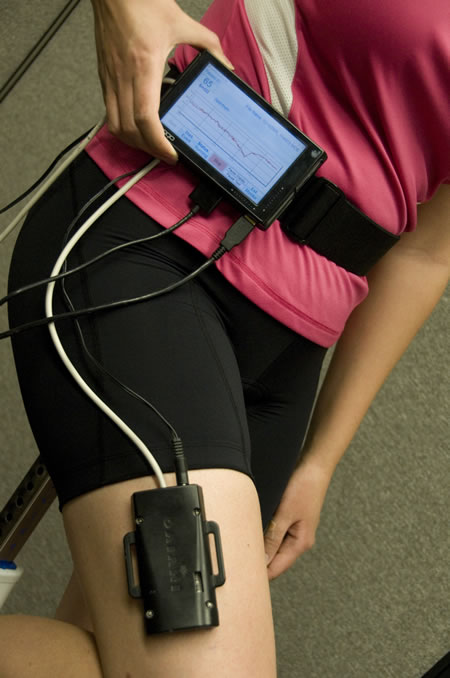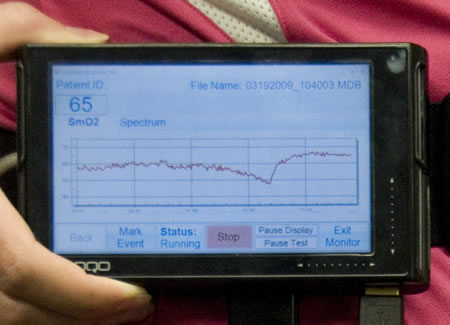Science Fiction
Dictionary
A B C D E F G H I J K L M N O P Q R S T U V W X Y Z
Venus Sensor And Portable Monitor For Dr. McCoy

The Venus prototype sensor and portable monitor uses a needle-free, noninvasive method to measure blood and tissue chemistry, metabolic rate (oxygen consumption) and other parameters for NASA astronauts in space. Venus will present a highly desirable alternative to painful needle sticks and bulky equipment to accept blood samples.
The Venus system is being developed by the National Space Biomedical Research Institute's (NSBRI) Smart Medical Systems and Technology team. The team is lead by Dr. Babs Soller, who points out the importance of this data to astronauts:
This picture shows the Venus prototype system in use.
“The measurement of metabolic rate will let astronauts know how quickly they are using up the oxygen in their life-support backpacks. If spacewalking astronauts run low on oxygen, the situation can become fatal.”

(Venus prototype sensor and portable monitor)
Placed directly on the skin, the four-inch by two-inch sensor uses near infrared light (that is just beyond the visible spectrum) to take the measurements. Blood in tiny blood vessels absorbs some of the light, but the rest is reflected back to the sensor. The monitor analyzes the reflected light to determine metabolic rate, along with tissue oxygen and pH. One unique advantage of Dr. Soller’s near infrared device is that its measurements are not impacted by skin color or body fat.
Take a closer look at the display for the Venus prototype:

(Venus close-up; sensor and portable monitor)
“Eventually, we expect first-responders would have these devices, which would provide feedback on the severity of a person’s injury,” Soller said. “Data can be communicated directly to the hospital. Early access to this type of information may increase a victim’s chances of survival.”
The Venus system could also be used in hospitals to monitor pediatric and long-term care patients; both groups of patients are particularly sensitive to the multiple needle sticks required for care. It could also be used for coaches of elite athletes.
Dr Soller and her colleagues are currently working to reduce the size of the device, improve its accuracy and develop the capacity to run on batteries.
Ideally, I'd like Dr. Soller to get this device as small as the advanced medical sensor shown in the following video.
(Replica of original Star Trek medical scanner prop, w/digital sound)
Starfleet will be grateful, and so will Dr. McCoy, who is offended by barbarous medical technology like sticking a metal needle into a patient. He's a doctor, not a butcher!
From Venus medical sensor and portable monitor; via jackofallgeek.
Scroll down for more stories in the same category. (Story submitted 5/13/2009)
Follow this kind of news @Technovelgy.| Email | RSS | Blog It | Stumble | del.icio.us | Digg | Reddit |
Would
you like to contribute a story tip?
It's easy:
Get the URL of the story, and the related sf author, and add
it here.
Comment/Join discussion ( 2 )
Related News Stories - (" Medical ")
Brain Implant Is Able To Capture Your Inner Dialogue
'So you see, you can hide nothing from me.'
'Pregnancy Humanoids' From China Replace Moms
'A great many of these synthetic babies were made...' - David H. Keller, 1928.
Bacteria Turns Plastic Into Pain Relief? That Gives Me An Idea.
'I guess there's nobody round this table who doesn't have a Crosswell [tapeworm] working for him in the small intestine.'
Heart Patches Grown In The Lab Repair Hearts
I'm hoping that this procedure becomes a normal part of medical practice!
Technovelgy (that's tech-novel-gee!) is devoted to the creative science inventions and ideas of sf authors. Look for the Invention Category that interests you, the Glossary, the Invention Timeline, or see what's New.
Science Fiction
Timeline
1600-1899
1900-1939
1940's 1950's
1960's 1970's
1980's 1990's
2000's 2010's
Current News
iPhone Air Fulfils Jobs' Promise From 2007 - A Giant Screen!
'... oblongs were all over the floor and surfaces.'
ChatGPT Now Participates in Group Chats
'...the city was their laboratory in human psychology.'
iPhone Pocket All Sold Out!
'A long, strong, slender net...'
Did The Yautja Have These First?
What a marvel of ingenuity the little device was!
Jetson ONE Air Races Begin, Can Air Polo Be Far Behind?
'If you're one of those rarities who haven't attended a rocket-polo "carnage", let me tell you it's a colorful affair.'
Will Space Stations Have Large Interior Spaces Again?
'They filed clumsily into the battleroom, like children in a swimming pool for the first time, clinging to the handholds along the side.'
Mornine Sales Robot
'Robot-salesmen were everywhere, gesturing...'
Bipedal Robot Floats Gently While Walking
'a walking balloon proceeded with long strides of its aluminum legs...'
Musk Idea Of Cars Talking To Each Other Predicted 70 Years Ago
'My cars talk to one another.'
Elegant Bivouac Shelter Produces Water And Electricity
'There was nowhere on the planet where science and technology could not provide one with a comfortable home...'
X-Control Janus-1 A Suitcase Aircraft
'You will notice that it... fits the suitcase nicely.'
'AI Assistants' Are Actually Less Reliable For News
'Most men updated their PIP on New Year's Day...'
YES!! Remote Teleoperated Robots predicted by Technovelgy!
'...a misshapen, many-tentacled thing about twice the size of a man.'
Will Robots Ever Fold Landry?
Where have you gone, Mrs. Robinson?
Will AIs Give Better Results If You're Rude To Them?
'I said, "Listen up, motherf*cker.'
Cybertruck Robotic Arm F10 Drone Launch!
Drone away!
